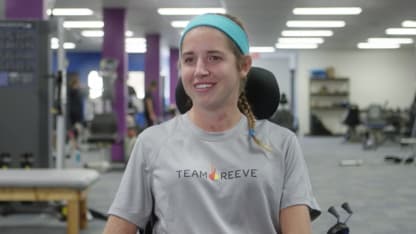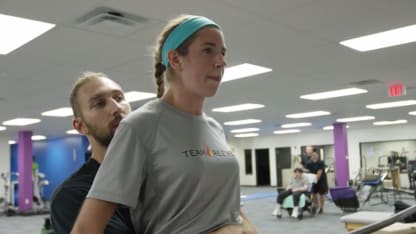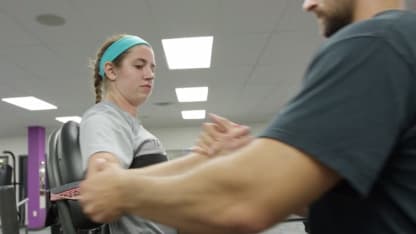CANTON, Mass. -It is still so visceral, that day. The air. The ice. The field. The crowd.
The details are there, waiting for her to grasp them once again. She seems to see it as she describes it, sitting on the bench, looking up at the stands, those first steps onto the ice.
Denna Laing relying on hard work, hope for recovery
Stays positive after injuring spinal cord in Outdoor Women's Classic

It was a moment that, until that morning, they hadn't been entirely sure they would have, with all the twists and turns in arrangements, with all the questions and complications. But there they were, on Dec. 31, on the field at Gillette Stadium, home of the New England Patriots, part of the pomp and the pageantry of the 2016 Bridgestone NHL Winter Classic. The women - in the form of the Boston Pride of the National Women's Hockey League and Montreal's Les Canadiennes of the Canadian Women's Hockey League - had been invited, for an exhibition game, the Outdoor Women's Classic, and for at least one Boston girl on the bench, it was pure joy.
"The day was perfect," Denna Laing recalls. "It really, really was."
\\\\
She couldn't move.
Laing had been skating in the corner and got tangled and went down and there was a stretcher and they were taking her off the ice and someone was taking pictures and she was trying to stop him. But she couldn't move.
Her parents arrived, her father, Dennis, having jumped down onto the field from the stands, where he was sitting in the first few rows. Her mother wasn't far behind.
"I tried to stay really, really calm because there was nothing I could do at that point," said Laing, 25. "No need to freak out. Wanted to keep everyone else level as well. My dad was one of the first people to get there and I was like, 'Dad, I need to you be calm.' I said, 'I can't feel my legs.'"
He couldn't help it. He panicked, a little.
She didn't. She knew enough, upon entering the ambulance, to insist they take her to Massachusetts General Hospital, rather than Norwood Hospital. She knew she needed more than the suburban outpost could give her. She also knew enough to blame her insistence on her mother, Jerilyn, who credits that moment with letting her know that even as so many things could change, Denna and her personality weren't going to be among them.
It got foggy later, when Laing was rushed into surgery three hours after the injury. She would remain there for more than seven hours. She had shattered her C5 vertebra in the front and fractured her C4, C5, and C6 in the back. (To be exact, it was a C5 vertical burst flexion teardrop fracture and a C4, C5, and C6 laminar fracture.) The fragments had to be removed. A titanium cage needed to be inserted, and the vertebrae stabilized with rods.

She remembers more clearly all the physical manifestations of support, the cards and the stuffed animals and the messages coming from as close as family and friends and as far away as Russia and Germany. The word had gone out in hockey circles, in a community that had seen other paralyzing spinal cord injuries, and whose eyes had already been focused on Boston that weekend with one of the NHL's signature events the next day, the Winter Classic between the Boston Bruins and Montreal Canadiens. The bouquets, which she could not have in the ICU, spilled over into friends' houses. The text messages numbered in the hundreds.
She would not leave Mass General for 133 days.
\\\\
As Laing explains something to a visiting cameraman on a recent Monday, her trainer tweaks up the resistance on the NuStep, a recumbent machine that brings to mind a seated elliptical. It helps to get her heart rate up, a difficult task for someone who spends almost all of her time confined to a wheelchair.
The goal today is half a mile. She alternates gritted-teeth concentration with the smile that characterizes so many descriptions of her. It is indeed startling to see how often a grin breaks across her face, even while she is giving maximum effort.
No one looks this happy in a gym.
And yet, it is a mark of normalcy that she is back here, back in a place that looks like a large gym floor, only with more trainers per client than the average facility. Here, they are not just barking out orders to people hoping to shave off a few pounds, shave off a few minutes. Here, they are supporting a pelvis, massaging muscles to retrain them to properly fire, lifting bodies that no longer are able to lift themselves.

"Everyone wants to be here," floor manager David Alexander said of his clients, of Laing. "They want to regain pieces of their life back."
Laing had spent the morning in the pool at Spaulding Rehabilitation Hospital. In the afternoon - and three more days per week - she is here, at Journey Forward, an exercise-based program in Canton, focusing solely on those with spinal cord injuries.
This work is what she knows, what she has done for so long, building her into a two-time captain of the women's hockey team at Princeton University, a player on the Boston Pride of the NWHL, a victim/witness advocate at the Essex County District Attorney's office and a future lawyer.
It is evident in all she says now, all she does.
"The shift before I went down I didn't think I did so well," Laing said of her injury. "I went into that shift and I was like, 'All right, Denna, you've got to pick it up, you've got to hustle, you've got to work your hardest.'
"And that's exactly what I was doing when I went into the boards. I was working my hardest, really hustling and it was really unfortunate that I had to go down like that. But I definitely went down working."
She has not stopped.
"It's really reassuring that I'm going in the right direction, that there is hope for better and also kind of reassuring seeing that hard work is paying off," Laing said. "That's always been one of my pillars, if you will, to work hard. I never thought I was the best or the smartest, but I definitely worked hard."
And there have been gains, in core strength, in trunk stability. When she first came into the gym at Journey Forward, she had to have aid to even move the gears of the NuStep. She recently graduated from level zero on the machine to level one. The steps are small, but they exist.
As Alexander, one of Laing's main trainers, said, "It's a game of inches."
\\\\
For now, so much is unknown. There is no telling whether Laing might get some sensation back, some function, whether walking is in her future, whether tomorrow will be better than today. Doctors shy away from predictions in such cases, and there is a sense that the first three years are crucial in knowing what will happen. Laing is just eight months in.
That is both forever and no time at all.
Laing does not have much control over her wrists and fingers, so she must use gloves and splints for moving around in her therapy pool and use a stylus to type on her computer and her phone. Her biceps are constantly firing and her triceps aren't working well. Her left arm has more ability than her right, so she has had to switch from being predominantly right-handed to left-handed. There is an imbalance in her shoulder blades, pulling them inward, which can be painful. Her temperature control is off, leading to near-constant coldness, something that will be corrected in the renovation of her family's Marblehead, Mass., home with special heating just for her room.
There are trials she could participate in, implants that might be options, but none of it can be tackled until she gets through more of the process, until she sees how far she can get on her own.
"I have a little [sensation] in my hands, not much really," Laing said. "Just my thumbs. But I definitely have sensation in my arms, my chest, my neck, some of my back, too. But it's not been great gains."

That is more than she initially had, but it's unclear whether there will be more, and how much.
As she said, "Definitely just one of the question marks."
One of a thousand.
But the thing is, Denna is still Denna, and that has been the most crucial part for her, for her family, for her ability to adapt. And the goal has been to continuously keep things as normal as possible, with a trip to the Princeton reunion in May, with weekends on Ossipee Lake in New Hampshire, with concerts at Gillette Stadium (Luke Bryan and Kenny Chesney), with plans for the future.
Although Laing already knows she will not attend law school this fall - she was in the midst of the application process at the time of the injury - and does not know exactly when she might matriculate, she has had interviews at schools in the Boston area. She completed applications while still in inpatient treatment. That part hasn't changed.
She hasn't changed, at the same time that everything has.
There is a particular day in her recovery Laing can point to, a day that meant the world to her. It was not long before she left the hospital, on May 24, on a mission to go to her second college reunion. It was two weeks earlier, on May 12, her 25th birthday.
"I was having a conversation with one of my friends one Saturday and I was like, 'I really miss Saturday nights, I really miss going out with my friends, I really miss being out on the dance floor.' Huge dancer," Laing recalled.
"So to go out with my friends and be out on the dance floor - I wasn't out there busting a move with my legs, but I was definitely having a good time, doing as much as I could. I think that night was really one of the big nights for me."
\\\\
The popular story is easy, the one in which Laing is always smiling, always fighting. And from all accounts, that is largely the truth, believing there is no space for negativity within the enormity of what she wants to accomplish. But, still, there are moments - of course there are - where that gets lost in the reality of everything she is facing, in the face of too much.
There are times she sends her mother out, off to get a coffee, just to have a little separation from the constant togetherness. She tears up when she speaks about what her family has done for her -- Jerilyn in particular, with her round-the-clock care of her daughter -- but for a 25-year-old fiercely proud of her previous independence, losing that freedom has not come easy.

"She's been amazing. I know it's really hard," Laing said, her eyes filling. "It's a lot for one person. And it kind of kills me too because I was so independent. But the best caregiver I could have, for sure."
Jerilyn, who worked briefly as a physical therapy assistant out of college, is there in the morning, sitting in a folding chair on the pool deck, after spending two hours helping her daughter get ready to leave the house. She is there following Laing's progress through the exercises at Journey Forward in the afternoon, moving her chair around the gym space as Laing shifts from machine to machine. She is there with a refillable bottle of water any time she is called for. She is there filming for progress reports and later viewings with her husband.
She is there because she needs to be there.
"I haven't seen her have those [down] moments," Jerilyn said. "Maybe once or twice where she's been discouraged or frustrated, but I think she just thinks of all the people that are cheering her on. She doesn't want to let them down.
"Plus, she hasn't gotten to the point where there's nothing happening. She's still improving. She's still hopeful."
What happens if that stops?
"I'm not really concerned about that because if it does come to that point, she's handled it so well that she's just going to use a stylus or - I think it still won't stop her from doing what she wants to do," Jerilyn said. "She's not going to not go to law school, she's not going to not have a job, she's not going to not be a wife or whatever she wants to do.
"I think it doesn't matter to her what she has to do to get to do those things. She's going to do them. So I'm not really worried. Like if someone has to brush her teeth, someone has to brush her teeth. It's not like she's not going to get up [in the morning] and be herself.
"There's lots of setbacks. All the other things that aren't functioning properly. That stuff is hard to deal with because she's not an elderly person. She's young. So I think that's hard. But it's not going to change, so you just deal with it."
Jerilyn is not the only one who has been there. The calls and visits and check-ins are constant, including from her teammates on the Pride who celebrated their NWHL championship with her the day after they won the Isobel Cup.
"It's hard to put into words how thankful I am," Laing said, her voice getting thick. "I know it's been hard on everyone else, too. This injury, you definitely can't fight it on your own."
But the love cannot erase everything. It cannot ease all the ills of someone going through what Laing is going through.
"I definitely have those moments," she said. "I definitely get upset about things. Usually I think about how me reacting would change a situation. So instead of getting angry or yelling at someone, that's not going to help. Nobody likes to be yelled at.
"So I try to stay calm about situations. I definitely get - there's days I definitely get down. But I'm pretty good at snapping myself out of it. I just take a second and close my eyes and take a couple deep breaths and really focus on saying, 'You know, Denna, you're going to get through this and it could be worse. And it will be better.'"
She is asked about that last part, about the better she can sense and feel, about the hope.
"It will be better," she repeats, more firmly.
\\\\
Eight months ago, Laing couldn't breathe. She was on a respirator. She couldn't hold her neck up. She couldn't clear her lungs of mucus. She couldn't move her left arm very much. She couldn't move her right at all.
"Every little step, every time I got stronger was just one more thing that I can do that keeps my spirits going," she said. "I'm really hopeful for the future. I don't think there's ever been a time that I've said, 'This is impossible,' or 'This is never going to happen.'
"I just can't close my mind down like that."
It is an attitude Alexander called "relatively positive, but realistic," something that doesn't always happen, especially in young people, usually desperate to find someone - anyone - who can tell them if and when they will walk again.

"The long-term goal, which is everyone's, is to walk," he said. "But first you have to go through progressions. You have to sit before you stand. You've got to stand before you can walk."
When Laing is on the treadmill at Journey Forward, it looks like she is marching, like she's moving on her own, like she's walking. She is not, and the videos of the exercise can be deceiving, could even deceive her as she watches herself on the mirror at the front of the machine. Her arms are swinging, her legs are moving up and down.
That doesn't take into account the trainer standing behind her, stabilizing her body, or the trainers sitting on either side, massaging and moving her legs to manually stimulate the muscles that are supposed to be working when walking.
She can see those legs. She cannot feel them.
She is supported. She is helped. She is smiling. And even if it's not on her own, even if the things that used to be under her control are no longer that way and may never be again, Laing is moving forward, one step at a time.

















